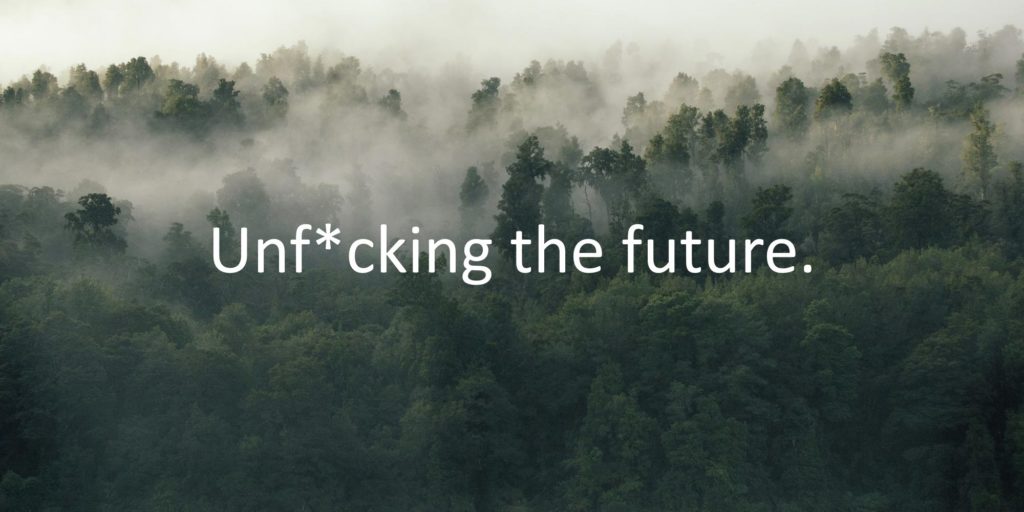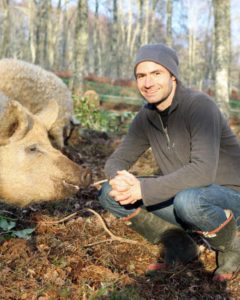Unf*cking the Future – Afforestation of Scotland with rock dust and biochar
(All photos courtesy of the Future Forest Company.)
Deep ecology inspires innovative business model
Founding a company committed to removing carbon dioxide from the atmosphere through forestry may not seem unexpected for someone who grew up on a dairy farm and studied ecology in university, but for Jim Mann, starting the Future Forest Company Ltd. marked a shift in his career. Mann spent decades as an entrepreneur focused on technology, retail, and leisure companies before turning his attention to climate change.The initial idea behind the Future Forest Company was to sequester carbon dioxide through reforestation and afforestation. Scotland does not currently have much forested land, and what little there is is mostly plantation forest, containing only one or two tree species, which are often genetically modified. Through large scale models, Mann hopes to create a market that can compete with these commercial operations. Wanting to focus on natural solutions, the goal, in Mann’s words, is “the right tree, the right place” to restore habitat for native species. Recognizing that planting trees alone is not enough to tackle climate change, Mann decided to add biochar and rock dust to capture more carbon dioxide.
Rock dust + biochar = quick growth and healthy trees
After a long period of small scale experimentation and fundraising, Future Forest bought 2,000 acres on the rainy Isle of Mull. Located on the west coast of Scotland, Mull has a large supply of basalt. There is a small quarry on Future Forest’s land, which is a source of rock dust for remineralization. Any basalt from their land cannot be taken off the property, so they also purchase a byproduct from a nearby basalt mine about five miles down the road. The rock dust is about three millimeters, similar to the size of sand grains. Future Forest then grinds it to 0.1 millimeters, approximately 140 mesh, and although they do not yet have their own grinding equipment, it will be arriving soon. With a reliable source of rock dust, Future Forest is well equipped to remineralize.
 Add biochar into the mix, and things really get going. Future Forest buys small branches left over from commercial forestry operations. Normally, this waste would be left on the forest floor to decompose and release greenhouse gases into the atmosphere. Instead, Future Forest converts it into biochar. Produced at high temperatures, this biochar is very stable and sequesters carbon for a longer time than biochar made at a lower temperature. In addition to carbon storage, the biochar also helps with water retention and drainage, and in combination with basalt rock dust, the benefits are even greater.
Add biochar into the mix, and things really get going. Future Forest buys small branches left over from commercial forestry operations. Normally, this waste would be left on the forest floor to decompose and release greenhouse gases into the atmosphere. Instead, Future Forest converts it into biochar. Produced at high temperatures, this biochar is very stable and sequesters carbon for a longer time than biochar made at a lower temperature. In addition to carbon storage, the biochar also helps with water retention and drainage, and in combination with basalt rock dust, the benefits are even greater.
Simultaneously applying biochar and rock dust supports soil fungi, which associate with tree roots and speed up the breakdown of the basalt. This makes cations from the rock dust accessible to trees, accelerating growth. The biochar absorbs the excess cations, and by keeping the environment damp, it increases the amount of time that rainwater (which is abundant on the Isle of Mull) is in contact with the basalt. Longer contact time for rainwater means more carbon sequestration via enhanced weathering.
Soils with a lot of fungi can also store more carbon than those with a lower fungal/bacteria ratio. If the soil is undisturbed, the transition to a fungi-dominated system typically takes about three decades. However, using a fungi-rich compost can accelerate fungal colonization from approximately 30 years to one year.
Although not proven scientifically, observations suggest that biochar can act as a growth medium for fungus by creating a carbon mesh that protects the hyphae from predators. Thus, rock dust + biochar + fungus in the presence of rainwater accelerates tree growth, enhances weathering, and increases soil carbon sequestration, all contributing to Future Forest’s climate mitigation goals. Mann explains the tripartite approach as a way to supercharge the process and restore degraded soils.
Visionary technology and scaling up
To further the impact of these forestry operations, Mann is integrating technological innovation into the forestry enterprise. Future Forest will be using renewable power for the rock crushing, thus removing the largest energy challenge for remineralization. To apply rock dust and biochar, Future Forest is at first designing their forests to be accessible for four-wheel drive vehicles.
 However, not leaving behind his background in the tech industry, Mann is also currently developing small, autonomous electric vehicles using robotics and artificial intelligence. Powered with renewable energy, the goal is for these vehicles to move through the forest and apply the mineral fertilizer and biochar. The vehicles will be able to drive through both established forest and areas that have not been forested before and will identify places where human help is needed to clear roots or other obstacles. Still in development, the goal is to have a demonstration vehicle ready in 2021. This technology has the potential to reduce the vehicle emissions of Future Forest, while also making it easier to apply biochar and rock dust.
However, not leaving behind his background in the tech industry, Mann is also currently developing small, autonomous electric vehicles using robotics and artificial intelligence. Powered with renewable energy, the goal is for these vehicles to move through the forest and apply the mineral fertilizer and biochar. The vehicles will be able to drive through both established forest and areas that have not been forested before and will identify places where human help is needed to clear roots or other obstacles. Still in development, the goal is to have a demonstration vehicle ready in 2021. This technology has the potential to reduce the vehicle emissions of Future Forest, while also making it easier to apply biochar and rock dust.
Overtime, Mann hopes to scale up his operation and to increase the amount of rock dust used in his forests. He is balancing the need for drastic climate mitigation action with the need to watch out for secondary effects that are not necessarily known. Although basalt is generally very safe, there is the potential for unintended consequences with high application rates in a very rainy area. Along with the Leverhulme Centre for Climate Change Mitigation, he is monitoring the downstream effects of large-scale remineralization. This is both to avoid negative outcomes that could result and also to observe the potential positive effects, which include reduced ocean acidification and increased fertility for photosynthetic microorganisms, particularly if remineralization is implemented at a large scale globally.
As a for-profit company, generating a return on investment for shareholders is a priority, and already Future Forest is breaking even, no longer reliant on external funding to grow. Although they can reinvest the profits, he would like to scale the organization more quickly. Having already raised about $7 million, the company is now looking to raise over $30 million to purchase more land and grow the team. He has set an ambitious goal to acquire and reforest 50,000 hectares in Scotland over the next five years.
Among their existing projects is Brodoclea, 430 acres of land just south of Glasgow, Scotland. “Our forest, Brodoclea is planted with mixed deciduous trees just like the native forest would have been. The planting plan, approved by Scottish Natural Heritage, adheres to our ethos to plant the right tree in the right place at all times.” As Future Forest grows, Mann hopes to demonstrate that it is possible to cost effectively reforest Scotland and make a profit while doing so.
Gift a tree or an entire forest
Anyone who would like to take part can buy a tree or an entire forest! As explained on the Future Forest website, “We’re on a mission to plant 50 million trees in the UK by 2030, by giving the gift of a forest you would be helping us on our way to reaching this goal. We plant trees in the UK, so you could visit your forest from time to time and see how it is growing.”
Mann recognizes that the time to take action on climate change is now. He founded the Future Forest Company on the conviction that there is not enough time to go through major social and political change before taking climate action, and that he could have the largest impact by working within the existing capitalist system to sequester carbon through innovative forestry techniques. Still in its early stages, the company is off to a strong start and holds promise for large scale tree planting and remineralization.
Emma Cutler holds a PhD in engineering sciences from Dartmouth College and a BA in math and environmental studies from Bowdoin College. Currently working on flood vulnerability assessments in the Great Lakes, she has experience in systems modeling for climate adaptation and studied sustainable agriculture movements in Sri Lanka as a Fulbright research student. She is passionate about translating science to non-technical audiences and incorporating science into decision making for climate action.
Support us on Patreon
Thank you for joining us today! Please become a member of RTE and support us on Patreon. Unlike many larger organizations, we work with a team of determined and passionate volunteers to get our message out. We aim to continue to increase the awareness of remineralization to initiate projects across the globe that remineralize soils, grow nutrient dense food, regenerate our forests’ and stabilize the climate – with your help! If you can, please support us on a monthly basis from just $2, rest assured that you are making a big impact every single month in support of our mission. Thank you!









Got something to say?